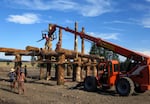
A team uses an all-terrain crane to place a log crossbeam in place on one of the structures that make up the Solar Temple.
Aaron Scott / OPB
Driving onto the site of the Oregon Eclipse Festival in eastern Oregon’s Big Summit Prairie feels like driving onto the set for “Mad Max 5: Total Eclipse of the Art.” Tattooed, tanned workers zip around on dirt bikes and all-terrain vehicles, clouds of dust chasing them across the high desert as they head from one construction zone to another.
Related: OPB's Coverage Of The Oregon Solar Eclipse 2017
While eclipse festivals big and small pop up across the state, this one stands out for its glitter-dusted audacity: It is perhaps the country’s biggest, most remote eclipse festival.
The hundreds of workers on-site a month in advance only hint at the 30,000 people to come from around the world for a week in the middle of the Ochocos National Forest from Aug. 17–23. Thirteen festival promoters from around the world have come together to organize the festival, complete with dozens of speakers, artists, workshops, and seven stages hosting 400 musical acts, mostly of varying shades of electronica.
“There’s more music than one person could even possibly fathom,” says Kevin KoChen, the marketing director and a partner in Symbiosis, the lead organization behind the festival. “It's like the lure to get people to come and experience this reality we’re creating. And the focus is on creating an artistic reality in which people can participate and enjoy."
Related: Stream opbmusic's sprawling, cheesy, irreverent eclipse playlist here.

A worker drives off in the direction of the main event area and the Big Summit Prairie.
Aaron Scott / OPB
KoChen gets into what looks like a souped-up, all-terrain golf cart to head out on a tour with creative director Bosque Hrbek and the landowner, Craig Woodward.
Starting at the clearing on the edge of the woods that will function as the camping area, we drive by an enormous tent that’ll house food booths and workshops, multiple structures and stages, a garden, and a lake, all on the way to the main event area on the edge of the prairie.
The scale is huge. But it reflects a festival 11 years in the making. Hrbek started the annual Symbiosis Gatherings in 2005 after attending a total eclipse festival himself.
“Going to an eclipse festival was a life-changing experience for me,” Hrbek says. “I was definitely after that an eclipse chaser. This will be my fifth eclipse.”
After attending a second eclipse festival in Turkey in 2006, he looked at a calendar and saw that the next eclipse in the U.S. was slated for 2017, and his team began looking for a site (they also continued to collaborate with festival organizers around the world on other eclipse festivals).
They chose Oregon for the high likelihood of clear skies and began calling parks departments and the Bureau of Land Management. Eventually they found Big Summit Prairie, a giant, privately owned clearing in the crown of the Ochoco Mountains that’s filled with wildflowers in the spring and cattle in the summer.

The sky spreads over RVs truck trailers, and the giant, orange food tent (on the right) — just a small section of the total festival area.
Aaron Scott / OPB
“I'm about as conservative and redneck as anyone you're ever going to find,” says Craig Woodward, whose roots in the prairie run deep. He worked as a summer cowboy there as a kid, like his father and grandfather before him. It was always his dream to own and preserve part of it. After building a large logging and real estate business, he was able to buy up 11,000 of its 55,000 acres.
But it’s not been easy. The rent he gets from grazing cattle isn’t keeping up with property taxes and fire patrol costs, to say nothing of the bottom falling out of the logging industry.
Related: Oregon Rainbow Gathering: Bliss For Campers, Headache For Forest Service
“That's why I'm dealing with what I'm dealing with here,” he says. “The local people say, ‘Craig, say it isn't true. You wouldn't let a bunch of hippies on your ranch would you?’ And I say, ‘Well, you have to reinvent yourself if you're going to stay alive.'"
First, Woodward called the counties that had housed previous Symbiosis Gathering and found the two main complaints were traffic and noise. Then he attended the festival in Oakdale, California, last year.
“I put on my big belt buckle and my cowboy hat, knowing I'd be the only one there like that, because I figured if someone was going to stand out, it may as well be me,” he recalls. “And it was as professionally run as any gathering I've ever seen. I mean, they had great security staff and medical staff. They had volunteers cleaning up after every stage event. Things were immaculate.”
Woodward agreed to rent 300 acres of marginal land called scab, and he’s provided much of the machinery to move earth, widen roads and build the stage, as well as salvaged timber and scrap materials for construction and art installations.

Landowner Craig Woodward (center) gives festival workers directions on earth moving form the top of the earthen amphitheater he shaped from a previously scraped part of land.
Aaron Scott / OPB
We stop at the Solar Temple, where a team is using a crane to lower a giant log crossbeam onto a structure that will be one of two portals on the east and west side of a giant moon-shaped clearing. Woodward has shaped a 9-foot-tall, tiered, earthen amphitheater ringing the north side.
The idea is that people will sit on the amphitheater and look over Big Summit Prairie as the moon covers the sun, its shadow moving from the east portal to the west.
“With the expansiveness, you’ll be able to see the shadow get cast across the whole prairie,” Hrbek says. “It will just shoot right across. It’s like 1,000 miles an hour.”
“They call that a wall of shadow,” KoChen adds.
Hrbek and KoChen say that Woodward's expertise and resources have been essential to prepare for 30,000 people — twice what they've handled in the past — and coordinate with local agencies. They've had to drill two wells and bury water lines to circulate potable water to holding tanks, showers, and water stations. The county required them to set up garbage collection, sewer lagoons and a pop-up hospital staffed by doctors and nurses. (They hired White Bird, the medical team that handles Oregon Country Fair.) And the U.S. Forest Service worked with them to clear the national forest roadsides leading up to the property of dry brush.
Not to say that the unique pairing of progressive, permaculture-obsessed event organizers and a conservative timber man hasn't been completely without bumps, although perhaps not the ones you'd expect.
"Mostly when someone takes a look at my ranch, they see it as a blank canvas in what they can do," Woodward says. "But we're trying to keep it pretty well constrained in an area that we feel there'll be no damage to. And we have different ideas of what is damage."
For instance, Woodward wouldn't let organizers bulldoze any untouched areas to level them for camping, requiring them to instead backfill soil to prevent destroying roots, and he's charged them to import infill material from other, already disturbed properties for leveling and padding the water-line trenches, as opposed to excavating it from this one.

One of several works of art and interactive installations created by earth art teams using fallen limbs, rocks, woodchips, and other scavenged materials.
Aaron Scott / OPB
Of course, the biggest concern is fire. But Woodward says he’s prepared.
“I've had a fire contract with the state for over 40 years,” he says. “I'll have three dozers on-site. I'll have at least three fire trucks on site. We have 8,000 acres of irrigated meadows, so we can move off this scab into a green area as part of our escape plan” — a plan that also includes four roads leaving the prairie in four different directions.
Related: Forestry Asks Landowners For Help Avoiding Eclipse Wildfires
County Judge Seth Crawford prefers having that many people in one controlled spot. “The positives would be: We know where those people are located, and we know that we’re able to put requirements on them to take care of those people,” he says. “The people I’m really worried about are the people out there randomly in the national forest.”
While the logistics are a monster challenge, the Oregon Eclipse Festival team revels in the details. We pass people making art installations and sculptures that visitors will wander upon as they explore the grounds. Another team is building a floating bridge across the lake, which will be filled with art barges. There’ll be a 1Nation Earth Camp coordinated by native and indigenous people, a giant “Wheel of Fortune” consisting of doorways that people can explore, an interactive Guerilla Science center, a bar dubbed the Glitter Ranch Saloon, and no end to surprises.
And everyone agrees it’s all in service of the real headliner: the sublime majesty that is a total eclipse.
